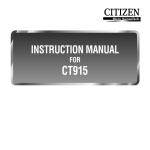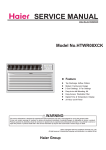Download Danby DDW497W Owner`s manual
Transcript
OWNER’S MANUAL GUIDE DU PROPRIÉTAIRE MANUAL DEL USARIO DDW497W CAUTION : Read and Follow All Safety Rules and Operating Instructions Before First Use of This Product. ATTENTION : Avant de faire fonctionner cette machine, lisez et suivez toutes les consignes de sécurité de ce guide en premier lieu. Table of Contents . . . . . . . . . . . . . . . . . . . . . . . 1 Table des matières . . . . . . . . . . . . . . . . . . . . . . 10 Índice . . . . . . . . . . . . . . . . . . . . . . . . . . . . . . . . 19 ATENCIÓN: Lea y Siga Todas las Indicaciones de Seguridad y de Operación Antes de Utilizar Este Producto. PostScript Picture (1-800 eps) Danby Products Limited, Guelph, Ontario Canada N1H 6Z9 Danby Products Inc., Findlay, Ohio USA 45840 version 1.12.07 Table of Conetents Unit Parts Identification . . . . . . . . . . . . . . . . . . . . . .1 Important Safety Information . . . . . . . . . . . . . . . . . .3 Installation Instructions . . . . . . . . . . . . . . . . . . . . . .4 Water Pressure . . . . . . . . . . . . . . . . . . . . . . . . . . . .4 Connecting your Dishwasher . . . . . . . . . . . . . . . . . .4 Disconnecting your Dishwasher . . . . . . . . . . . . . . . .5 Loading your Dishwasher . . . . . . . . . . . . . . . . . . . .5 Preparing your Dishes for Washing . . . . . . . . . . . . .5 Using the Right Detergent . . . . . . . . . . . . . . . . . . . .5 How Much Detergent you Should Use . . . . . . . . . . .6 Using a Rinse Agent . . . . . . . . . . . . . . . . . . . . . . . .6 The Pre-wash Program . . . . . . . . . . . . . . . . . . . . . .6 Using Intensive Wash . . . . . . . . . . . . . . . . . . . . . . .6 Using Economy Wash . . . . . . . . . . . . . . . . . . . . . . .6 Operating Instructions . . . . . . . . . . . . . . . . . . . . . . .7 Program Summary/Selection . . . . . . . . . . . . . . . . . .7 Common Diswasher Problems & Solutions . . . . . . .8 Warranty . . . . . . . . . . . . . . . . . . . . . . . . . . . . . . . . . .9 Inspect the unit for damage, ensure all parts and accessories are included and read these instructions thoroughly before attempting operation. Unit Parts Identification 3 1 4 2 5 6 7 8 9 Part Identification 1. Door 2. Door window 3. Door open button 4. Display window 5. Program button 6. Delay button: Pressing this button delays the start of a wash cycle by up to 24 hours. Each press delays the start by one hour. 1 7. Start/Reset button 8. Power indicator 9. On / Off button Unit Parts Identification Detergent Dispensers Rear of Dishwasher Rear of Dishwasher: 1. Inlet Port 2. Drain Port 3. Power Cord Detergent Dispensers: Top: Liquid measurer Bottom: Powder measurer 1 2 3 Quick Connect Assembly 4 6 Drain Hose 5 Quick Connect Inlet Hose 1 7 8 2 9 3 10 11 Dishwasher Cavity 1 4 2 5 3 2 Quick Connect Assembly Inlet Hose: 1. Inlet port connection 2. Quick connect connection Drain Hose: 3. Drain port connection 4. Quick connect connection Faucet Adapter: 5. Faucet Adapter 6. Faucet washer Quick Connect: 7. Pressure relief valve 8. Faucet adapter connection 9. Locking collar 10. Inlet hose connection 11. Drain hose connection Dishwasher Cavity: 1. Spray Arm Assembly 2. Inner door panel 3. Rinse agent dispenser 4. Filter screen 5. Detergent fossa IMPORTANT SAFETY INFORMATION PostScript Picture (Caution eps) WARNING PostScript Picture (Caution eps) PostScript Picture (Caution eps) DANGER PostScript Picture (Caution eps) Dishwasher detergent is a strong alkaline and can be extremely dangerous if swallowed; avoid contact with skin and eyes and keep children away from the dishwasher when the door is open. Check that the detergent receptacle is empty at the end of each wash cycle. When loading your dishwasher, follow basic safety precautions, including the following; • Read all instructions before using the dishwasher. • Use the dishwasher only for its intended function (normal, household use only). • Use only detergents or wetting agents recommended for use in a dishwasher; do not use them for hand-washing, and keep them out of the reach of children. PostScript Picture (Caution eps) WARNING PostScript Picture (Caution eps) Instructions pertaining to the risk of fire, electric shock or injury to persons. When loading items to be washed: • Locate sharp items (e.g. forks or knives) so that they are not likely to damage the door seal. • Load sharp knives with the handles up to reduce the risk of cut-type injuries. • Do not wash plastic items unless they are marked “dishwasher safe” or the equivalent. For plastic items not so marked, check the manufacturer’s recommendations. • Do not touch the heating element (located under the filter) during or immediately after use. • Do not operate the dishwasher unless all enclosure panels are properly in place. • Do not tamper with controls. • Do not abuse, sit on or stand on the door or dish-rack of the dishwasher. • To reduce the risk of injury, do not allow children to operate (or play in or on) the dishwasher. • Do not allow children to play around the dishwasher when opening or closing the dishwasher door. • Under certain conditions, hydrogen gas may be produced in a hot-water system that has not been used in two weeks or more. Hydrogen gas is explosive. If the hot-water system has not been used for such a period, before using the dishwasher, turn on all hot water faucets and let the water flow from each for several minutes (this will release any accumulated hydrogen gas). As hydrogen gas is flammable, do not smoke or use an open flame during this time. • Remove the door to the washing compartment when removing an old dishwasher from service or discarding it. • Do not spray water on the appliance (it may cause electric shock or failure of electrical parts). Eectrical Instructions: An electrical supply of 120V AC only, 60 Hz is required. For your personal safety, the appliance must be grounded. This appliance is equipped with a power cord having a 3-prong grounding plug. To minimize possible shock hazards it must be plugged into a matching 3-prong (grounding type) electrical outlet. If the power cord is damaged, it must be replaced by the manufacturer or its service agent, or a similarly qualified person in order to reduce the risk of a hazard. Grounding Instructions: This appliance must be grounded. In the event of a malfunction or breakdown, grounding will reduce the risk of electric shock by providing a path of least resistance for the electric current. This appliance is equipped with a cord having an equipment-grounding conductor and a grounding plug. The plug must be plugged into an appropriate outlet that is installed and grounded in accordance with all local codes and ordinances. SAVE THESE INSTRUCTIONS! 3 Installation Instructions PostScript Picture (Caution eps) WARNING PostScript Picture (Caution eps) A hose that attaches to a sink spray can burst if it is installed on the same water line as the dishwasher. If your sink has one, it is recommended that the hose be disconnected and the hole plugged. Connecting your Dishwasher Your dishwasher comes equipped with a ‘quick connect’ assembly (includes inlet and drain hose). The faucet adapter must be installed on the faucet before you can connect the dishwasher. This adapter is included inside your dishwasher. The faucet adapter is compatible with faucets inclusive of either male (outside) or female (inside) threaded faucet connections. Remove All Packaging Materials Carefully. If your existing faucet adapter is not compatible with the “quick connect” hose assembly supplied; • Connect the faucet adapter (included with dishwasher) to your faucet. • If your faucet is inclusive of a ‘male’ type (threaded) connection, use only the standard rubber washer (0.2”/5mm thick) supplied inside the adapter. Remove the second rubber washer. • If your faucet is inclusive of a ‘female’ type (threaded) connection, both rubber washers must be installed inside the faucet adapter. • The minimum height clearance required to install your dishwasher on a countertop surface with overhead cupboards is 45cm (17.7”). • Make sure there is an electrical supply (outlet) within reach of the electrical power supply cord (195 cm / 6.3 ft). • Make sure the water supply/faucet connection is within reach of the inlet & drain hose assembly (i.e., 58 cm / 22.8”). • The dishwasher must be installed on a solid, level surface. • Screw the faucet adapter onto (or into) the faucet tap. Check for leaks (use Teflon tape to eliminate if necessary). • Connect the six-sided connection of the drain hose to the drain port connection on the back of the dishwasher cabinet. Do not over-tighten (to avoid damage to threads). • Connect the star-shaped connection of the inlet hose to the inlet port on the back of the dishwasher cabinet. Do not over-tighten (to avoid damage to threads). • Connect the circular connection of the drain hose onto the longer (bottom) male connection on the quick connect. • Connect the circular connection of the inlet hose onto the shorter (top) male connection on the quick connect. • Attach the quick connect onto the faucet adapter, by pulling down the outer locking collar on the quick connect, while pushing the quick connect upward onto the faucet adapter. • When the quick connect snaps onto the faucet adapter, release the locking collar. Verify the connection is secure. • Slowly open the hot water line and check for any sign of water leaks at all hose connections. If leaks are located, immediately close the water supply and repair the hose connections. Water Pressure For best operating results, incoming water pressure should be between 15 and 20 pounds per square inch (psi). For the Best Results: Your dishwasher cleans by spraying a mixture of hot clean water and detergent (under pressure) against the soiled surfaces of dishes. The water is pumped through a rotating spray arm, drained through a filter (removing food and soiled particles) and pumped back through the spray arm. Soiled water is pumped out and replaced with clean water at the end of each cycle, (the number of times depends on the wash program being used). For best cleaning results, the water temperature must be at least 55ºC (130ºF). To prevent damage to the dishwasher, the temperature of the incoming water supply should not exceed 65ºC (149ºF). 4 PostScript Picture (Caution eps) IMPORTANT Loading your Dishwasher PostScript Picture (Caution eps) The dishwasher is designed to receive a standard ‘4piece’ plate setting, consisting of the following: • 4 dinner plates • 4 soup plates • 4 dessert dishes • 4 saucers • 4 cups • 4 tea spoons • 1 oval platter • 1 small serving • 1 dish • 4 glasses • 4 soup spoons • 4 forks • 4 knives • 4 dessert spoons • 2 serving spoons • 1 serving fork • 1 gravy ladle • Once you open the water supply line, (even if it is closed immediately thereafter), the inlet hose will be pressurized. • To relieve water pressure from inside the inlet hose, (make sure the water line (faucet) is closed): press and hold the red pressure relief button on the quick connect until the flow of water stops. PostScript Picture (Caution eps) WARNING PostScript Picture (Caution eps) FAILURE TO RELIEVE WATER PRESSURE, BEFORE DISCONNECTING THE QUICK-CONNECT FROM THE FAUCET, WILL RESULT IN BACK-PRESSURE OVER-SPRAY. THE TEMPERATURE OF INCOMING WATER CAN BE VERY HOT, AND BACK-PRESSURE OVER-SPRAY COULD CAUSE SEVERE BURNS AND/OR SCALDING. PostScript Picture (Caution eps) DANGER NOTE: For ease of loading/unloading large size dinner plates from the dishrack, it may be necessary to temporarily remove the silverware basket. When loading/unloading is complete, return the silverware basket to its original position. PostScript Picture (Caution eps) DO NOT LET CHILDREN DISCONNECT THE DISHWASHER; CLOSE SUPERVISION OF CHILDREN IS ALWAYS IMPORTANT AROUND APPLIANCES. Preparing your Dishes for Washing NOTE: Hard water conditions will adversely affect the washing performance of your dishwasher. Hard water conditions will also contribute to ‘lime’ (white film substance) deposits and/or ‘scaling’ on the stainless steel surface of the dishwasher tub and heater element, located in the sump underneath the removable filter screen. To assist in minimizing these conditions, it is recommended to periodically operate/rinse the inside of the dishwasher (empty) using 1 cup of white vinegar at least once a week. • • • • Scrape off all solid food particles from dishes. Remove excessive quantities of oil or grease. Empty any liquids from glasses and cups. All dishes should be thoroughly rinsed before being placed inside the dishwasher. Note: Dishes with dried on foods are more difficult to wash and may not come clean in a normal wash cycle. Using the Right Detergent Disconnecting your Dishwasher Use only detergent specifically made for use in dishwashers (other types will cause over-sudsing). If your detergent is old and/or lumpy, throw it away, as old detergent loses its washing power and lumpy detergent won’t dissolve. • Close the hot water supply at the faucet. • Disconnect the power supply cord. • Remember to release the water pressure inside the inlet hose. Press and hold the red pressure relief button on the quick-connect until the flow of water stops. • Disconnect the quick-connect hose assembly by pulling down on the outer locking collar, (thus releasing the quick-connect from the faucet adapter). 5 How Much Detergent You Should Use Using Intensive Wash (P1) That depends if your water is ‘hard’ or ‘soft’: Hard water requires more detergent to get dishes clean; soft water requires less. • The recessed detergent area located on the inside door panel will hold approximately 20 grams of detergent. The Intensive wash feature gives you the option of washing/drying dishes at very high water temperatures. When activated, the intensive wash feature energizes a heating element that will raise and maintain the internal water temperature of the dishwasher at 69ºC (156.2ºF). PostScript Picture (Caution eps) Using a Rinse Agent CAUTION PostScript Picture (Caution eps) Water temperatures this high can cause severe burns/scalding; therefore, always exercise extreme care when opening and/or entering the dishwasher during the Intensive, Economy and Normal wash cycles, especially during their respective rinse cycles. You can help prevent unsightly spots on dishes and glassware and reduce drying time by using a rinse agent. A rinse agent is specially formulated to rinse away food and detergent residues that can be left behind on your dishes. Used regularly, a rinse agent will automatically provide you with cleaner dishes every time you wash. • To fill the rinse agent dispenser: unscrew the dispenser cap located on the inner door. Add the rinse agent slowly into the container until it just reaches the bottom of the filling cap inside the dispenser opening. Replace the cap. The dispenser automatically releases the rinse agent into the final rinse water at the end of the wash cycle. The dispenser holds approximately 125 ml (4.2 fl. oz.) of rinse agent. To activate this feature, push the program button until “P1” (intensive wash) appears in the display window. • Push the start button and the intensive wash program activates (“P1” remains in the display window, and flashes when complete). PostScript Picture (Caution eps) IMPORTANT PostScript Picture (Caution eps) For the drain system to operate properly the highest distance between the faucet quick connect and the base of the dishwasher should not exceed 15 cm (6 inches). Using Economy Wash (P4) The economy program gives you the option of washing dishes at normal incoming water tank temperature, (usually between 54.4º~ 60ºC / 130º~ 140ºF). When activated, the economy program ‘de-energizes’ (bypasses) the dishwasher’s heating element. To activate the economy program: • Push the program button on the control panel until “P4” appears in the display window. • Push the Start/Reset button and the economy feature activates (“P4” remains in the display window, and flashes when complete). The Pre-wash Program (P5) The Pre-wash is a convenience program that allows dishes to be rinsed if you don’t have a full load ready to be washed (preventing foods from becoming dried or caked on to dish surfaces). It is not necessary to add detergent to the dishwasher during the Pre-wash cycle; however, due to the short duration of the Pre-wash cycle (6 minutes only), make sure the incoming water supply is hot. Open the hot water faucet and run till hot before connecting the dishwasher. PostScript Picture (Caution eps) IMPORTANT PostScript Picture (Caution eps) IMPORTANT PostScript Picture (Caution eps) Drying time for dishes will be longer after using the economy program. Dishes are dried by a ‘convection’ method only. To speed-up the drying time, it is suggested that the dishwasher door be left partially open after program completion. This will allow humidity from within the dishwasher to escape. Push the door open button, and the door will pop open to a pre-set convection dry position. PostScript Picture (Caution eps) Your dishwasher is not a “garburator”; clean off large particles of food sediments before placing dishes in the dishwasher. 6 Common Dishwasher Problems & Solutions PROBLEM POSSIBLE CAUSE SOLUTON The dishwasher will not start. • Dishwasher not receiving electrical power. • Check electrical connection (fuse / circuit breaker). • Door is unlatched. • Close and latch door. • Dishwasher not level. • Level unit. • Improper loading. • Array dishes so spray action reaches all surfaces. Dishes are not clean. • Do not overload dishwasher. • Spray arm not rotating freely. • Check spray arm to make sure nothing (e.g. cutlery) is obstructing spray arm rotation. • Check if filter screen has become dislodged and is obstructing spray arm rotation. • Not enough detergent and/or improper detergent being used. • Use more dishwasher detergent. • Do not use detergent that is hard or caked. • Use only a recommended dishwasher detergent. • Improperly prepared dishes. • Excess food soil and liquids should be removed from dishes before loading. • Water inlet hose kinked/bent due to improper installation. • Eliminate kink or bend from inelet hose. Chipping or breaking of glassware. • Improper loading of dishes. • Do not overload dishrack. Load glasses on the upper rack only; not over dishrack pins. Glases loaded over dishrack pins are not properly supported and are subject to damage. Water remains in bottom of dishwasher • A small amount of water (in sump area) is normal. • This is necessary to keep the pump primed and is drained automatically at the beginning of each cycle. • Excessive amount of water; cycle not completed. • Allow dishwasher to complete full cycle. 8 Operating Instructions Program Summary/Selection To operate the dishwasher; 1. Attach the quick connect hose assembly to the faucet. 2. Push the door release button to open the door. 3. Check to make sure the filter is securely in its position. 4. Place dishes on the dish-rack and cutlery inside the cutlery basket. 5. Check to make sure the spray-arm can rotate freely by gently spinning it clockwise. 6. Fill the detergent fossa, located in the recessed area on the inner door panel (up to 12 grams). NOTE: If using the Pre-wash cycle only, it is not necessary to add any detergent. 7. Firmly close the door. 8. Open the hot water line. 9. Push the power on/off button inward. Power button pushed in = on Power button pushed out = off The LED indicator (located just above the power button) will illuminate, thus confirming that the dishwasher is receiving power. 10.Press the program button until the desired program code appears in the display window. The program codes are: P1, for Intensive wash P2, for Normal wash P3, for Rapid wash P4, for Eco wash P5, for Pre-wash 11.Press the Start/Reset button to begin the selected washing program. The display window will flash the program code throughout the cycle. At the end of the cycle the dishwasher will stop; the LED will stop flashing the program code, and the dishwasher will sound a beep. After ten minutes, the display window will stop displaying the program code and become blank (black). The power indicator light remains on unless the power is turned off (the power on/off button is pushed out). You can select another program during operation by pressing the Start/Reset button, then pressing the program key (until the desired program code appears in the display window), and finally by pressing the Start/Reset button again to confirm program choice. The dishwasher will restart and begin the selected wash operation. Note: For safety reasons, the dishwasher is designed to stop in the event that the door is opened during a wash cycle. IMPORTANT: Once washing is complete, press the door open button and leave the dishwasher for about fifteen minutes. This allows the dishes to cool off, as they may be too hot to touch immediately after washing. 12. After unloading the dishwasher, remove the metallic filter screen (located on the bottom of the dishwasher tub), and wash off any bits of food that may be caught in it, then return the filter to its proper position. NOTE: At the beginning of each cycle the dishwasher starts in drain mode. This is because the drain pump always retains a small amount of water (in the sump) from the previous (last) cycle. This is necessary to keep the pump primed; therefore, do not be alarmed if you see a small amount of water being pumped-out from the drain hose prior to the start of a regular wash cycle. (normal). Intensive wash (P1) Water Temperature: Program Duration: Water Consumption: Normal wash (P2) Water Temperature: Program Duration: Water Consumption: Rapid wash (P3) Water Temperature: Program Duration: Water Consumption: Economy wash (P4) Water Temperature: Program Duration: Water Consumption: Pre-Wash (P5) Water Temperature: Program Duration: Water Consumption: Wash 54ºC (129.2ºF) / Rinse 69ºC (156.2ºF) 125 minutes 10.4 L (22 pts) Wash 52ºC (125.6ºF) / Rinse 67ºC (152.6ºF) 130 minutes 10.4 L (22 pts) Wash 49ºC (120.2ºF) / Rinse 55ºC (131ºF) 70 minutes 9.6 L (20.3 pts) Wash 54ºC (129.2ºF) / Rinse 69ºC (156.2ºF) 120 minutes 10.4 L (22 pts) Incoming water (tank temperature) 12 minutes 5.4 L (11.4 pts) Note: Washing time may vary depending on incoming water temperature and the relevant environmental temperature. ERROR CODES: E1: Water pressure problem / water not running properly. Check connections, check that water is turned on. E2: Drain blockage / Drain hose kink. E3: Thermostat or Heater element damaged / not functioning properly. E4: Water level switch defective. 7









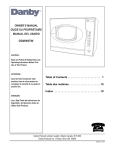
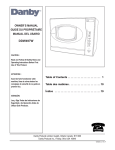
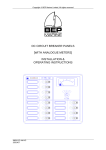
![ac circuit breaker panels [without meters] installation - thornam-shop](http://vs1.manualzilla.com/store/data/006886941_1-35cc363a8b64d2c248bc8206f0066550-150x150.png)


